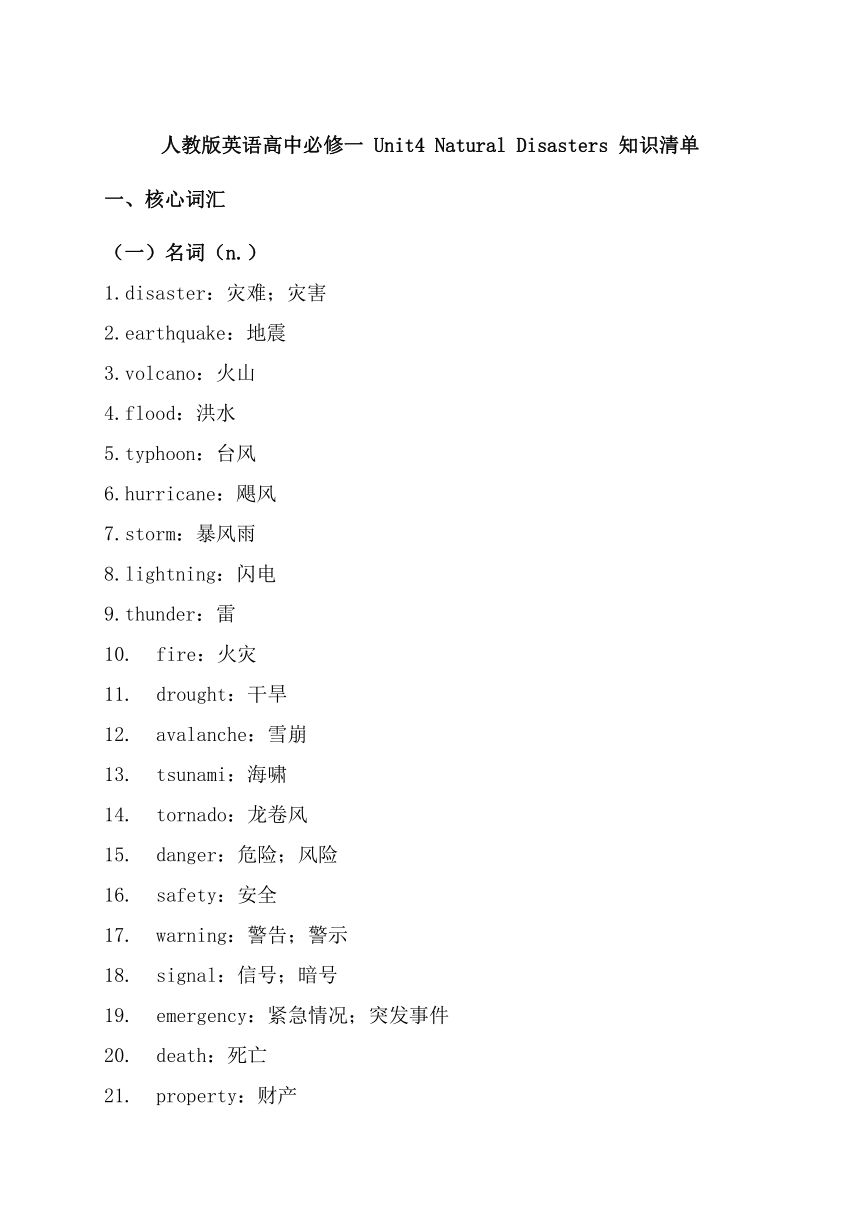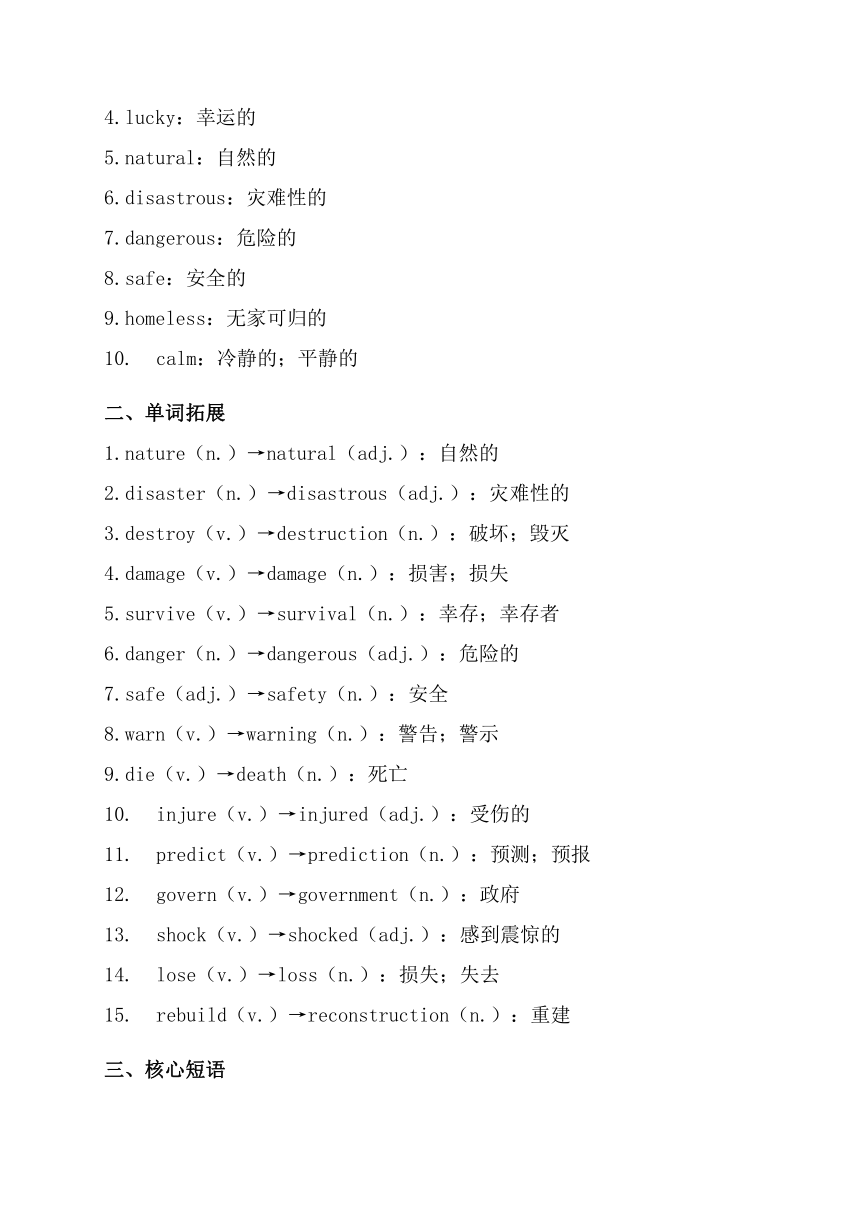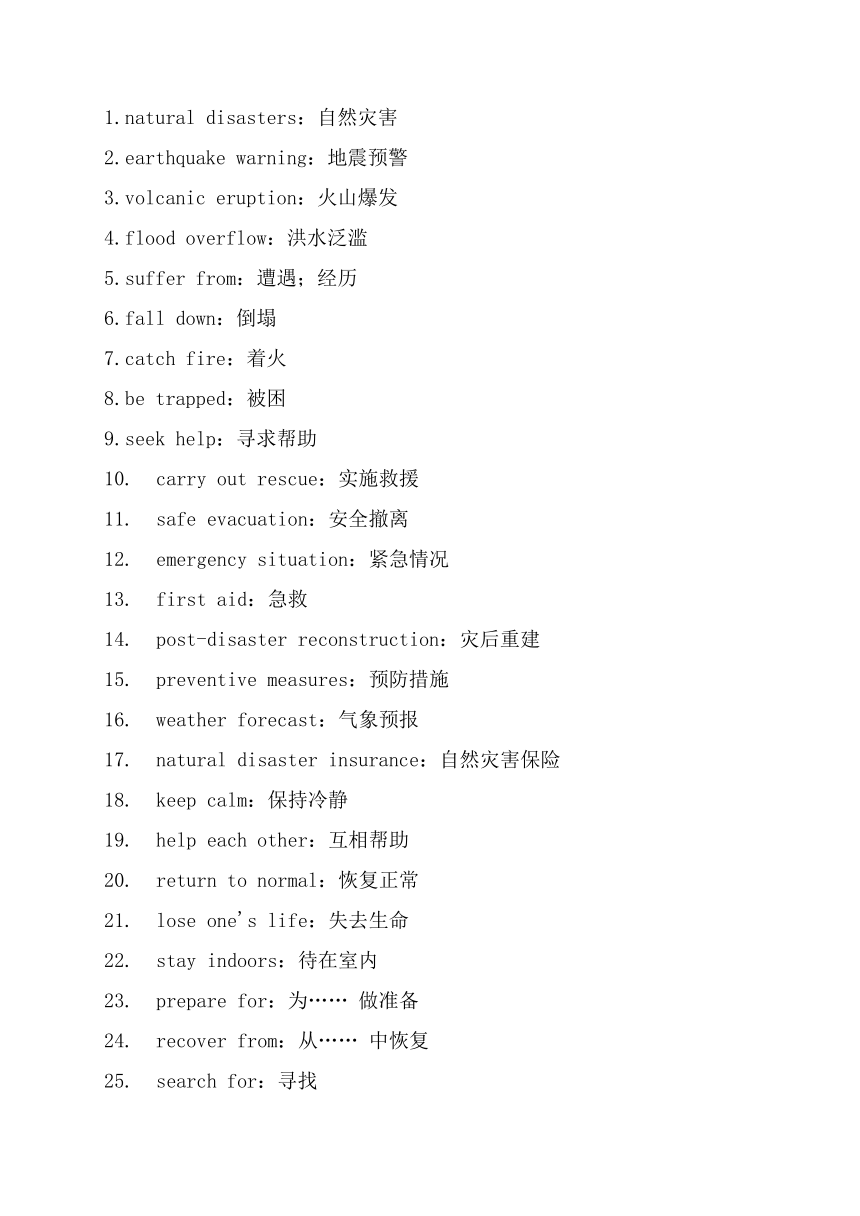Unit4 Natural Disasters单元知识清单(讲义)-2025-2026学年高中英语人教版(2019)必修第一册
文档属性
| 名称 | Unit4 Natural Disasters单元知识清单(讲义)-2025-2026学年高中英语人教版(2019)必修第一册 |  | |
| 格式 | docx | ||
| 文件大小 | 20.4KB | ||
| 资源类型 | 教案 | ||
| 版本资源 | 人教版(2019) | ||
| 科目 | 英语 | ||
| 更新时间 | 2025-08-02 13:07:46 | ||
图片预览




文档简介
人教版英语高中必修一 Unit4 Natural Disasters 知识清单
一、核心词汇
(一)名词(n.)
disaster:灾难;灾害
earthquake:地震
volcano:火山
flood:洪水
typhoon:台风
hurricane:飓风
storm:暴风雨
lightning:闪电
thunder:雷
fire:火灾
drought:干旱
avalanche:雪崩
tsunami:海啸
tornado:龙卷风
danger:危险;风险
safety:安全
warning:警告;警示
signal:信号;暗号
emergency:紧急情况;突发事件
death:死亡
property:财产
survivor:幸存者
victim:受害者
reconstruction:重建
forecast:预报
(二)动词(v.)
destroy:毁灭;破坏
damage:损害;伤害
lose:失去;丢失
survive:幸存;活下来
rescue:救援;营救
shelter:避难;躲避
warn:警告;警示
happen:发生
erupt:爆发
flow:流动;溢出
fall:倒塌;落下
injure:伤害;使受伤
prepare:准备
search:寻找;搜寻
provide:提供
(三)形容词(adj.)
injured:受伤的
collapsed:倒塌的
terrible:可怕的;糟糕的
lucky:幸运的
natural:自然的
disastrous:灾难性的
dangerous:危险的
safe:安全的
homeless:无家可归的
calm:冷静的;平静的
二、单词拓展
nature(n.)→natural(adj.):自然的
disaster(n.)→disastrous(adj.):灾难性的
destroy(v.)→destruction(n.):破坏;毁灭
damage(v.)→damage(n.):损害;损失
survive(v.)→survival(n.):幸存;幸存者
danger(n.)→dangerous(adj.):危险的
safe(adj.)→safety(n.):安全
warn(v.)→warning(n.):警告;警示
die(v.)→death(n.):死亡
injure(v.)→injured(adj.):受伤的
predict(v.)→prediction(n.):预测;预报
govern(v.)→government(n.):政府
shock(v.)→shocked(adj.):感到震惊的
lose(v.)→loss(n.):损失;失去
rebuild(v.)→reconstruction(n.):重建
三、核心短语
natural disasters:自然灾害
earthquake warning:地震预警
volcanic eruption:火山爆发
flood overflow:洪水泛滥
suffer from:遭遇;经历
fall down:倒塌
catch fire:着火
be trapped:被困
seek help:寻求帮助
carry out rescue:实施救援
safe evacuation:安全撤离
emergency situation:紧急情况
first aid:急救
post-disaster reconstruction:灾后重建
preventive measures:预防措施
weather forecast:气象预报
natural disaster insurance:自然灾害保险
keep calm:保持冷静
help each other:互相帮助
return to normal:恢复正常
lose one's life:失去生命
stay indoors:待在室内
prepare for:为…… 做准备
recover from:从…… 中恢复
search for:寻找
四、经典句式
过去进行时与一般过去时连用:People were sleeping when the earthquake happened.(地震发生时,人们正在睡觉。)
“疑问词 + 不定式” 结构:We should learn how to protect ourselves.(我们应该学会如何保护自己。)
主谓宾结构:The storm destroyed many houses.(暴风雨摧毁了许多房屋。)
动名词作主语:Keeping calm is very important.(保持冷静很重要。)
系表结构:They became homeless after the flood.(洪水过后,他们无家可归。)
现在进行时:Rescuers are searching for survivors.(救援人员正在搜寻幸存者。)
provide sth. for sb. 句型:The government provided help for the disaster victims.(政府向灾民提供了帮助。)
be lucky to do sth. 句型:He was lucky to survive the fire.(他很幸运在火灾中幸存下来。)
It takes...to do sth. 句型:It takes a lot of money to rebuild the city.(重建城市需要很多钱。)
should do sth. 句型:We should prepare for natural disasters.(我们应该为自然灾害做准备。)
五、语法要点
(一)时态
一般过去时:表示过去发生的动作或存在的状态,常与 last year, yesterday, ago 等时间状语连用。例如:A big earthquake happened in that area last year.
过去进行时:表示过去某一时刻或某一段时间正在进行的动作,常与 when 引导的时间状语从句连用(主句用过去进行时,从句用一般过去时)。例如:People were sleeping when the earthquake happened.
现在进行时:表示现在正在进行的动作。例如:Rescuers are searching for survivors.
(二)被动语态
表示主语是动作的承受者,其基本结构为 “be + 过去分词”。例如:We were warned to stay away from the dangerous area yesterday.(昨天我们被警告远离危险区域。)
(三)非谓语动词
动词不定式:可作主语、宾语、表语、定语、状语等。常见结构有 “疑问词 + 不定式”“it's + 形容词 + to do sth.”“need to do sth.”“advise sb. to do sth.” 等。例如:It's important to keep calm when facing a natural disaster.
动名词:可作主语、宾语等。常见结构有 “动名词作主语”“spend time doing sth.”“be busy doing sth.”“be good at doing sth.” 等。例如:Staying calm is very important in an emergency.
六、重点词汇用法详解
(一)名词用法
disaster:既可指具体的某次灾难,也可泛指灾难这一概念。
具体灾难:The earthquake was a terrible disaster.(这次地震是一场可怕的灾难。)
泛指:Natural disasters can happen at any time.(自然灾害随时可能发生。)
emergency:强调突然发生的、需要立即处理的紧急情况。
例:We should keep a first - aid kit for emergencies.(我们应该为紧急情况准备一个急救箱。)
survivor:指在灾难、事故等中幸存下来的人。
例:The survivors of the flood were sent to a safe place.(洪水的幸存者被送到了安全的地方。)
(二)动词用法
destroy:强调彻底破坏,使其失去原有功能或价值,一般不用于被动语态。
例:The fire destroyed the entire building.(大火烧毁了整栋大楼。)
damage:指对事物造成一定程度的损害,但不一定是彻底毁坏,可用于被动语态。
主动:The storm damaged many houses.(暴风雨损坏了许多房屋。)
被动:Many houses were damaged by the storm.(许多房屋被暴风雨损坏了。)
survive:作及物动词时,后接灾难、事故等名词;作不及物动词时,意为 “幸存下来”。
及物:He survived the earthquake.(他在地震中幸存了下来。)
不及物:Only a few people survived in the accident.(在这次事故中只有少数人幸存下来。)
(三)形容词用法
dangerous:用于描述事物具有危险性。
例:It's dangerous to walk on the ice.(在冰上行走很危险。)
safe:表示安全的状态。
例:We are now in a safe place.(我们现在在一个安全的地方。)
homeless:指无家可归的,常用来修饰人。
例:The government helped the homeless people.(政府帮助了那些无家可归的人。)
七、重点句型深度解析
过去进行时与一般过去时连用
结构:主语 + was/were + doing + when + 主语 + did
用法:when 引导的时间状语从句表示一个短暂的动作,主句表示在这个短暂动作发生时正在进行的动作。
拓展:还可以用 while 引导时间状语从句,此时主从句都用过去进行时,表示两个动作同时进行。例如:While we were having dinner, the phone rang.(我们正在吃晚饭时,电话响了。)
“疑问词 + 不定式” 结构
构成:what/which/how/when/where + to do
用法:在句中可作主语、宾语、表语等。作宾语时,常接在 know, learn, decide, forget 等动词后。
例:I don't know what to do next.(我不知道接下来该做什么。)(作宾语)
It takes...to do sth. 句型
结构:It takes (sb.) some time/money + to do sth.
用法:it 是形式主语,真正的主语是后面的动词不定式短语。
例:It took them three months to build the house.(他们花了三个月的时间建造这所房子。)
八、常见错误辨析
destroy 与 damage
错误:The heavy rain destroyed the crops a little.
正确:The heavy rain damaged the crops a little.
辨析:destroy 表示彻底毁坏,而此处只是说雨水对庄稼造成了一点损害,应用 damage。
survive 与 survival
错误:His survive in the accident surprised us all.
正确:His survival in the accident surprised us all.
辨析:survive 是动词,此处需要名词作主语,应用 survival。
keep calm 与 stay calm
两者意思相近,都表示保持冷静,在大多数情况下可以互换。
例:Keep calm!/Stay calm!(保持冷静!)
九、单元话题相关表达
描述自然灾害的影响:Natural disasters can cause great loss of life and property.(自然灾害会造成巨大的生命和财产损失。)
谈论应对措施:We should follow the instructions of the authorities when a natural disaster happens.(当自然灾害发生时,我们应该听从当局的指示。)
表达希望与祝愿:We hope that the people affected by the disaster can recover soon.(我们希望受灾难影响的人们能尽快恢复。)
一、核心词汇
(一)名词(n.)
disaster:灾难;灾害
earthquake:地震
volcano:火山
flood:洪水
typhoon:台风
hurricane:飓风
storm:暴风雨
lightning:闪电
thunder:雷
fire:火灾
drought:干旱
avalanche:雪崩
tsunami:海啸
tornado:龙卷风
danger:危险;风险
safety:安全
warning:警告;警示
signal:信号;暗号
emergency:紧急情况;突发事件
death:死亡
property:财产
survivor:幸存者
victim:受害者
reconstruction:重建
forecast:预报
(二)动词(v.)
destroy:毁灭;破坏
damage:损害;伤害
lose:失去;丢失
survive:幸存;活下来
rescue:救援;营救
shelter:避难;躲避
warn:警告;警示
happen:发生
erupt:爆发
flow:流动;溢出
fall:倒塌;落下
injure:伤害;使受伤
prepare:准备
search:寻找;搜寻
provide:提供
(三)形容词(adj.)
injured:受伤的
collapsed:倒塌的
terrible:可怕的;糟糕的
lucky:幸运的
natural:自然的
disastrous:灾难性的
dangerous:危险的
safe:安全的
homeless:无家可归的
calm:冷静的;平静的
二、单词拓展
nature(n.)→natural(adj.):自然的
disaster(n.)→disastrous(adj.):灾难性的
destroy(v.)→destruction(n.):破坏;毁灭
damage(v.)→damage(n.):损害;损失
survive(v.)→survival(n.):幸存;幸存者
danger(n.)→dangerous(adj.):危险的
safe(adj.)→safety(n.):安全
warn(v.)→warning(n.):警告;警示
die(v.)→death(n.):死亡
injure(v.)→injured(adj.):受伤的
predict(v.)→prediction(n.):预测;预报
govern(v.)→government(n.):政府
shock(v.)→shocked(adj.):感到震惊的
lose(v.)→loss(n.):损失;失去
rebuild(v.)→reconstruction(n.):重建
三、核心短语
natural disasters:自然灾害
earthquake warning:地震预警
volcanic eruption:火山爆发
flood overflow:洪水泛滥
suffer from:遭遇;经历
fall down:倒塌
catch fire:着火
be trapped:被困
seek help:寻求帮助
carry out rescue:实施救援
safe evacuation:安全撤离
emergency situation:紧急情况
first aid:急救
post-disaster reconstruction:灾后重建
preventive measures:预防措施
weather forecast:气象预报
natural disaster insurance:自然灾害保险
keep calm:保持冷静
help each other:互相帮助
return to normal:恢复正常
lose one's life:失去生命
stay indoors:待在室内
prepare for:为…… 做准备
recover from:从…… 中恢复
search for:寻找
四、经典句式
过去进行时与一般过去时连用:People were sleeping when the earthquake happened.(地震发生时,人们正在睡觉。)
“疑问词 + 不定式” 结构:We should learn how to protect ourselves.(我们应该学会如何保护自己。)
主谓宾结构:The storm destroyed many houses.(暴风雨摧毁了许多房屋。)
动名词作主语:Keeping calm is very important.(保持冷静很重要。)
系表结构:They became homeless after the flood.(洪水过后,他们无家可归。)
现在进行时:Rescuers are searching for survivors.(救援人员正在搜寻幸存者。)
provide sth. for sb. 句型:The government provided help for the disaster victims.(政府向灾民提供了帮助。)
be lucky to do sth. 句型:He was lucky to survive the fire.(他很幸运在火灾中幸存下来。)
It takes...to do sth. 句型:It takes a lot of money to rebuild the city.(重建城市需要很多钱。)
should do sth. 句型:We should prepare for natural disasters.(我们应该为自然灾害做准备。)
五、语法要点
(一)时态
一般过去时:表示过去发生的动作或存在的状态,常与 last year, yesterday, ago 等时间状语连用。例如:A big earthquake happened in that area last year.
过去进行时:表示过去某一时刻或某一段时间正在进行的动作,常与 when 引导的时间状语从句连用(主句用过去进行时,从句用一般过去时)。例如:People were sleeping when the earthquake happened.
现在进行时:表示现在正在进行的动作。例如:Rescuers are searching for survivors.
(二)被动语态
表示主语是动作的承受者,其基本结构为 “be + 过去分词”。例如:We were warned to stay away from the dangerous area yesterday.(昨天我们被警告远离危险区域。)
(三)非谓语动词
动词不定式:可作主语、宾语、表语、定语、状语等。常见结构有 “疑问词 + 不定式”“it's + 形容词 + to do sth.”“need to do sth.”“advise sb. to do sth.” 等。例如:It's important to keep calm when facing a natural disaster.
动名词:可作主语、宾语等。常见结构有 “动名词作主语”“spend time doing sth.”“be busy doing sth.”“be good at doing sth.” 等。例如:Staying calm is very important in an emergency.
六、重点词汇用法详解
(一)名词用法
disaster:既可指具体的某次灾难,也可泛指灾难这一概念。
具体灾难:The earthquake was a terrible disaster.(这次地震是一场可怕的灾难。)
泛指:Natural disasters can happen at any time.(自然灾害随时可能发生。)
emergency:强调突然发生的、需要立即处理的紧急情况。
例:We should keep a first - aid kit for emergencies.(我们应该为紧急情况准备一个急救箱。)
survivor:指在灾难、事故等中幸存下来的人。
例:The survivors of the flood were sent to a safe place.(洪水的幸存者被送到了安全的地方。)
(二)动词用法
destroy:强调彻底破坏,使其失去原有功能或价值,一般不用于被动语态。
例:The fire destroyed the entire building.(大火烧毁了整栋大楼。)
damage:指对事物造成一定程度的损害,但不一定是彻底毁坏,可用于被动语态。
主动:The storm damaged many houses.(暴风雨损坏了许多房屋。)
被动:Many houses were damaged by the storm.(许多房屋被暴风雨损坏了。)
survive:作及物动词时,后接灾难、事故等名词;作不及物动词时,意为 “幸存下来”。
及物:He survived the earthquake.(他在地震中幸存了下来。)
不及物:Only a few people survived in the accident.(在这次事故中只有少数人幸存下来。)
(三)形容词用法
dangerous:用于描述事物具有危险性。
例:It's dangerous to walk on the ice.(在冰上行走很危险。)
safe:表示安全的状态。
例:We are now in a safe place.(我们现在在一个安全的地方。)
homeless:指无家可归的,常用来修饰人。
例:The government helped the homeless people.(政府帮助了那些无家可归的人。)
七、重点句型深度解析
过去进行时与一般过去时连用
结构:主语 + was/were + doing + when + 主语 + did
用法:when 引导的时间状语从句表示一个短暂的动作,主句表示在这个短暂动作发生时正在进行的动作。
拓展:还可以用 while 引导时间状语从句,此时主从句都用过去进行时,表示两个动作同时进行。例如:While we were having dinner, the phone rang.(我们正在吃晚饭时,电话响了。)
“疑问词 + 不定式” 结构
构成:what/which/how/when/where + to do
用法:在句中可作主语、宾语、表语等。作宾语时,常接在 know, learn, decide, forget 等动词后。
例:I don't know what to do next.(我不知道接下来该做什么。)(作宾语)
It takes...to do sth. 句型
结构:It takes (sb.) some time/money + to do sth.
用法:it 是形式主语,真正的主语是后面的动词不定式短语。
例:It took them three months to build the house.(他们花了三个月的时间建造这所房子。)
八、常见错误辨析
destroy 与 damage
错误:The heavy rain destroyed the crops a little.
正确:The heavy rain damaged the crops a little.
辨析:destroy 表示彻底毁坏,而此处只是说雨水对庄稼造成了一点损害,应用 damage。
survive 与 survival
错误:His survive in the accident surprised us all.
正确:His survival in the accident surprised us all.
辨析:survive 是动词,此处需要名词作主语,应用 survival。
keep calm 与 stay calm
两者意思相近,都表示保持冷静,在大多数情况下可以互换。
例:Keep calm!/Stay calm!(保持冷静!)
九、单元话题相关表达
描述自然灾害的影响:Natural disasters can cause great loss of life and property.(自然灾害会造成巨大的生命和财产损失。)
谈论应对措施:We should follow the instructions of the authorities when a natural disaster happens.(当自然灾害发生时,我们应该听从当局的指示。)
表达希望与祝愿:We hope that the people affected by the disaster can recover soon.(我们希望受灾难影响的人们能尽快恢复。)
